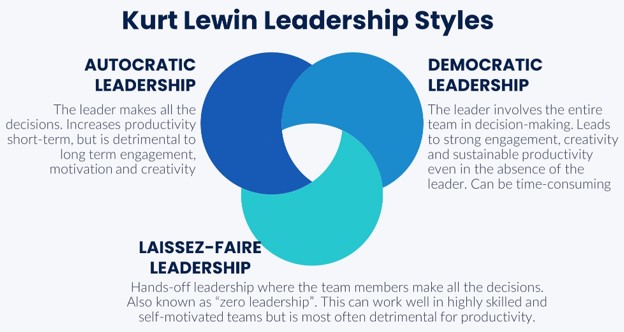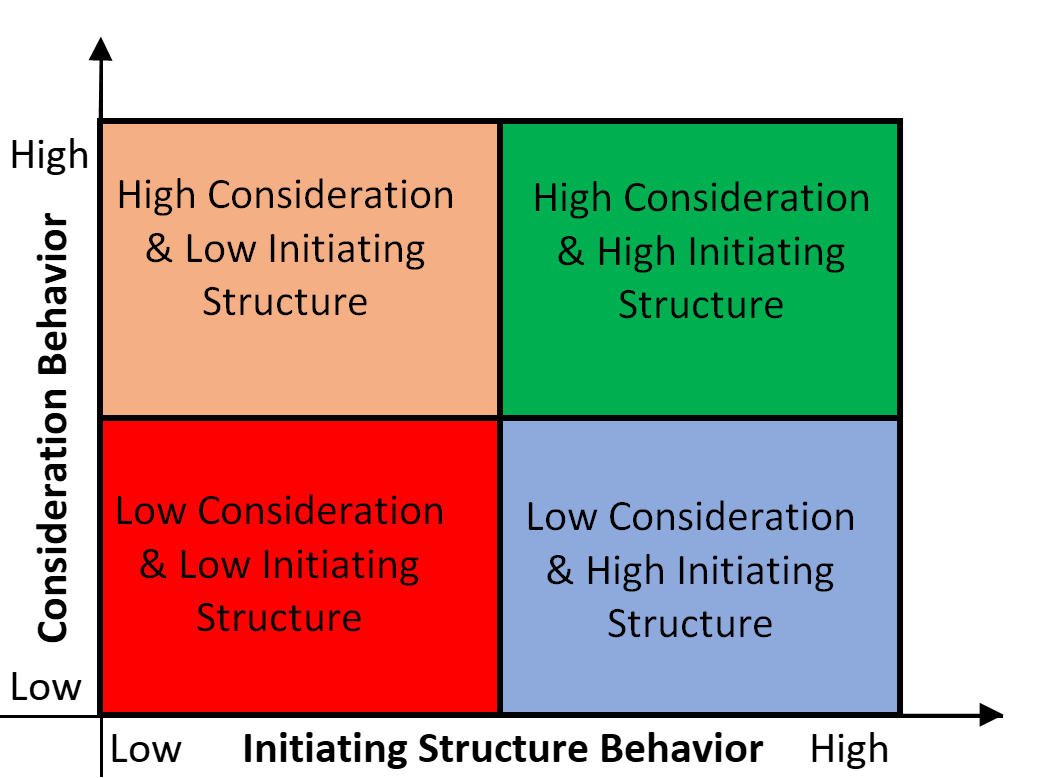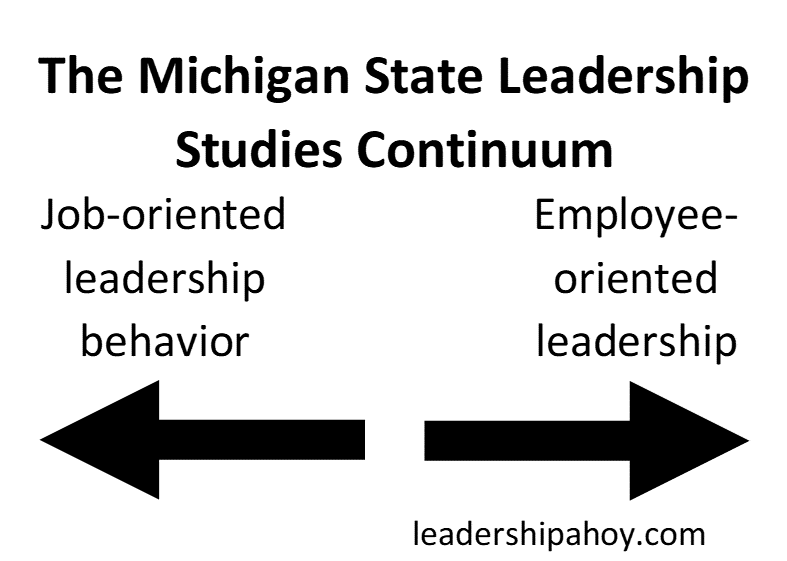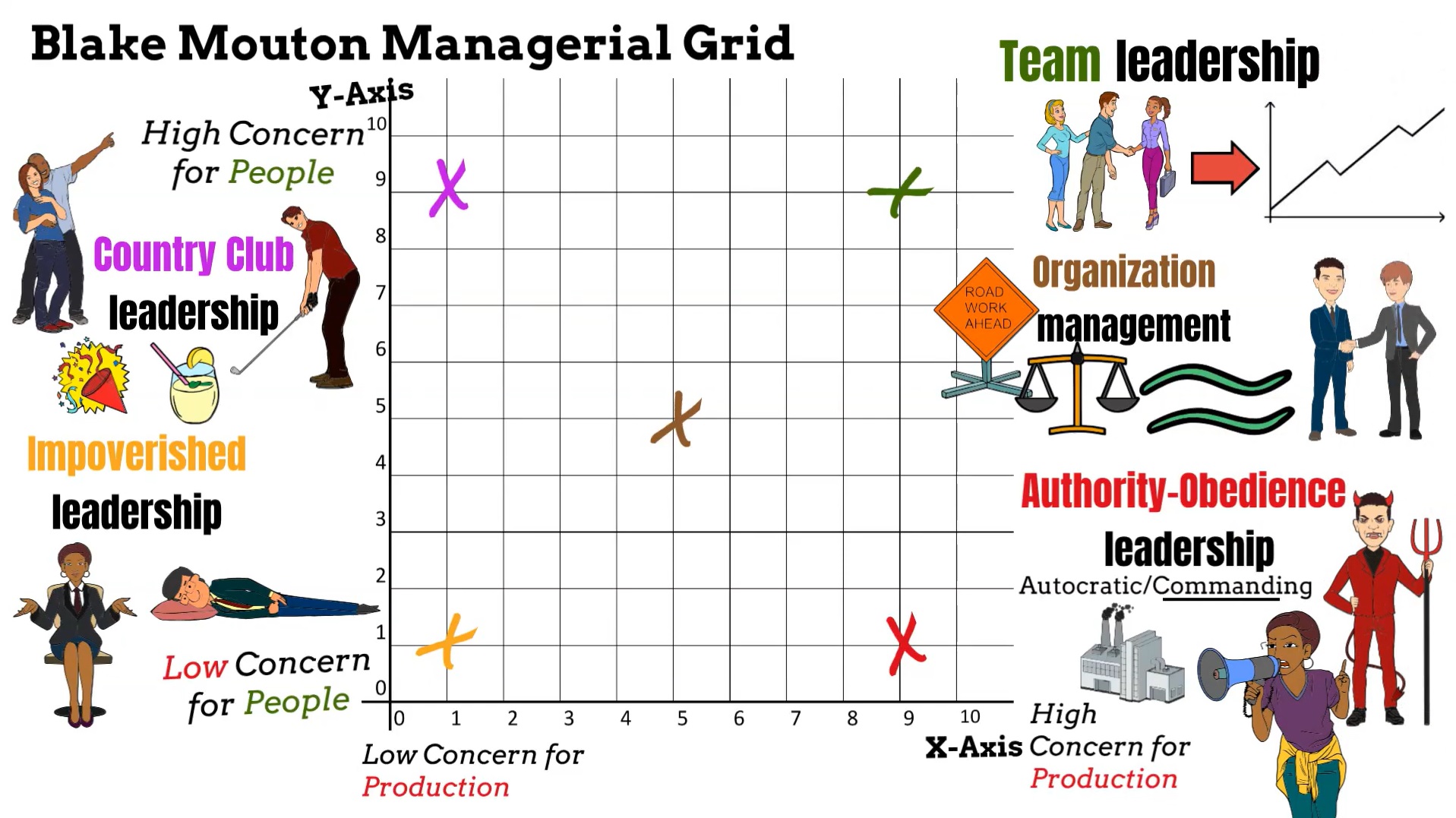Behavioral leadership theory focuses on the effects and effectiveness of different leadership behaviors. As a CEO, I constantly study the leadership behaviors of others to assess performance, leadership capabilities, etc. The behavioral theory of leadership is essential to this day, and lots of the previous research on behavioral leadership formed the foundation of the situational approaches to leadership that most great leaders use today.
What is behavioral leadership theory?
Behavioral leadership theory is a field of research focusing on the effects of different leadership behaviors. Several behavioral leadership studies have concluded that the best leaders are both production and people-oriented, such as the Ohio and Michigan Leadership Studies.
This article explains the behavioral theory of leadership, provides several examples of it, some of its history, and a few examples of leadership behaviors in leadership situations. (You can also take a look at our leadership styles portal for a great number of leadership articles or get our Leadership Origins E-book which contains more than ten important leadership theories. Great reference material and a true learning experience.)
Behavioral Theory of Leadership: Introduction, History, Origins
The phenomenon of leadership is in the spotlight of many organizational and psychological studies. The leadership concept first appeared in scientific studies in the early 1300s, but the scientific research in leadership began for real in the late 1800s. Despite leadership being a key topic in human interaction, the research field is relatively new, and lots of studies have been completed within a relatively short time [8]. A surprising amount of the early leadership studies were undertaken simultaneously. Due to this, there are some overlaps and intersections between various theories.
In the evolutionary tree of leadership theory, the behavioral theory of leadership comes third after the Personality era (Great man theory and Trait theory) and the Influence era (Power relations period and Persuasion period), and before the contingency theory of leadership that came slightly later.
As the name implies, the behavioral theory of leadership focuses on how different leaders behave and act toward others. The complete focus on behaviors puts the qualities of a leader aside and concentrates only on the concrete actions that leaders undertake. Some behavioral theories assume that leaders have a certain innate behavior as part of a personality. In contrast, other behavioral leadership theories assume that any leader can display or emulate specific behaviors to succeed. None of the behavioral leadership theories assume that you are born a leader (as the Great Man Theory does).
Behavioral leadership researchers study patterns in behavior, which are then further defined, grouped, and categorized. The end goal is to conclude which behaviors result in the most effective leadership and organizational performance and which behaviors lead to low productivity, demotivation, and other characteristics signifying poor performing organizations. In some theories, different combinations of behaviors form different behavioral leadership styles, such as autocratic leadership, country club leadership, produce-or-perish leadership, and more. We will take a look at these behavioral leadership theories later in this article.
The thought that certain behaviors lead to better performance and organizational success, combined with the position that leaders can learn new skills and behaviors and use them to solve problems, increase performance and leadership effectiveness, changed things radically. Behavioral leadership theory opened up new possibilities for leadership development compared to previous ideas of the trait theory of leadership.
The four major behavioral leadership theories
Four different behavioral leadership theories emerged in the time frame of 1930-1970, and they will be introduced below in chronological order, even though some overlap makes that rather difficult.
Which are the Behavioral leadership theories?
The behavioral leadership theories are:
- The Kurt Lewin Leadership styles
- The Ohio State University Leadership Studies
- The University of Michigan Leadership Studies
- Blake and Mouton's Managerial Grid
This chapter introduces you to each of these four behavioral leadership theories.
Behavioral Theory of Leadership: The Kurt Lewin Leadership Studies
The Lewin leadership experiment and leadership styles emerged in the 1930s and 1940s, a time when trait theories of leadership were popular. The Lewin leadership styles toolbox is behavioral, meaning that every leader has one of three personalities or behaviors. Nothing in this framework mentions taking the situation and other circumstances into account, making it outdated compared to the Goleman Leadership Styles and the Full Range Leadership Model with its transformational leadership style.
Kurt Lewin (1890-1947) worked on a few leadership experiments in the United States together with Ronald Lippitt and Ralph White in 1938 and 1939. The experiments involved 10-year old boys being studied in different settings. Groups of children were led with different" philosophies" of leadership. These "philosophies" or leadership styles were:
- Authoritarian or Autocratic Leadership Style, where the leader holds all decision power and essentially dictates what the group should do
- Laissez-Faire Leadership Style, also known as delegative or hands-off leadership style, means that the group get to make all the decisions without any participation by the leader
- Democratic Leadership Style, also known as Participative Leadership, where the group makes the decisions together with the leader who also acts as a facilitator

The three leadership styles of the Lewin experiments. Feel free to use the image as long as you link back to this webpage.
The Lewin leadership styles are some of the most commonly mentioned, and it is also the worst collection of styles for modern leaders, in my opinion. Please don't use it; employ other leadership styles instead. You can learn more about all this in our Lewin leadership styles article.
Behavioral Theory of Leadership: The Ohio State University Leadership Studies
In the mid-1940s, when trait theory was still dominant within the field of leadership studies, researchers at Ohio State University sought to draw conclusions of how different leadership behaviors affected leadership performance.
After successfully identifying several different behaviors affecting leadership performance, these were grouped into two categories: Initiating Structure and Consideration behavior.
Initiating Structure is a category of leadership behaviors aimed at creating clarity and structure for an organization. High levels of Initiating-Structure behavior mean a high definition of roles, tasks, expectations, schedules, etc., which leaves few uncertainties for the employees. High levels of Initiating Structure behavior also mean the leader makes all decisions, punishes sub-par performance among followers, and underlines the importance of results.
Consideration behavior is a category of leadership behaviors focusing on relationships and the welfare of people. The level of Consideration behaviors set the leader's level of empathy and focus on people. High consideration behavior signifies a strive for trust, interest in the followers' feelings, and a willingness to create warm relationships within the team. A leader with high consideration behavior uses active listening, understands the strengths and weaknesses of each team member, and supports them as required.
The Ohio State leadership research suggests that these two leadership behaviors lead to four possible outcomes, or quadrants, with four different leadership styles reflecting the leader's behavior. The most important conclusions of the Ohio State Leadership Studies are that the most effective leaders display high consideration behavior and a high initiating structure at the same time and that leadership can be learned. Compared to other studies and theories at the time, the assumption that leaders could elicit two types of behaviors at the same time was also new.

Ohio State Leadership Studies Leadership Styles, feel free to use the image as long as you link back to this page.
This description is an extract from our Ohio State Leadership Studies article, which also contains the sources for the above summary.
Behavioral Theory of Leadership: The University of Michigan Leadership Studies
The Michigan University leadership studies of the 1950s used surveys and interviews to identify behaviors common for the most effective leaders. The approach involved behavioral leadership theory only, discounting the situation of the leaders or whether they varied their behavior over time.
The Michigan University Leadership studies found two categories of leadership behaviors: job-oriented and employee-oriented leadership behaviors. The Michigan Leadership Studies emphasized that both employee-oriented and job-oriented leaders could be good and deliver excellent performance. The Michigan studies also added a team element to their research, which was a bit of a novelty in leadership research at the time.
As with most behavioral leadership approaches, the Michigan leadership studies suggest that these two leadership behaviors are mutually exclusive, and a single leader cannot display both types of behaviors. Thus, leaders are either employee-oriented or job-oriented (also referred to as production-oriented in some sources). Later additions concluded that the two leadership styles did not have to be mutually exclusive. In fact, the final conclusion was that employee-oriented leaders who also emphasized performance showed the best production levels in the end.

Michigan State Leadership Studies. Feel free to use the image as long as you link back to this webpage.
You can read more in our in-depth article on the Michigan Leadership Studies, from which the above short description was extracted. The Michigan leadership article also contains the references for this short summary.
Behavioral Theory of Leadership: Blake and Mouton's Managerial Grid
The Blake and Mouton Managerial Grid is a behavioral leadership model developed in the 1960s. The Managerial grid enables leaders to use a visual aid to quickly assess which leadership style they use, depending on their levels of concern for people versus production.
Concern for people involves the well-being, care, and importance given to employees and other human stakeholders. Concern for production involves caring for output, results, and other non-human things.
The Blake and Mouton Managerial grid shows five management styles plotted on a graph where the y axis shows the leader's level of Concern for People, and the x-axis shows the leader's Concern for Production. The extreme cases are Team Management at 9,9 and Impoverished Management at 1,1 in the grid.
The five management styles of Blake and Mouton's Managerial Grid are:
Impoverished Management
Impoverished Management means little concern for production and little concern for people. This type of manager displays little concern in general and only does the minimum required to avoid getting fired. Impoverished Management qualifies for the lowest position in the graph, which is 1,1.
Country Club Management
The name of this style, Country Club Management, makes you associate with harmony and comfortable living. It is plotted at the top left in the Blake and Mouton Managerial Grid, i.e., high on the y-axis and low on the x-axis at position 1,9. Country Club Management means excellent concern for people but low concern for production, resulting in happy employees but meager output.
Authority-Compliance Management
Positioned in another extreme position in the managerial grid, the Authority-Compliance or Authority-Obedience style is high on production and low on concern for people. This leader gives orders and directs people to execute them without much care for emotions. Performance is what matters the most. This management style leads to high turnover, low engagement, and perhaps even to a toxic work climate.
Learn more about this style in our detailed article here: Authority-Obedience Management, or Produce-or-Perish Management as it is also called.
Middle-of-the-Road Management
Middle-of-the-road leadership, also known as organization management, has no extreme and is plotted at the dead center, resulting in a compromise of concern for people and production (5, 5). This leader tries to balance having good performance while still having consideration for the people. Leading with this style results in less than maximum output, but it also leads to a better situation for the people involved. Hence, it got the very descriptive name of middle-of-the-road leadership.
Team Management
The last style is plotted at the top right corner and shows great concern for both people and production. This is the most effective leadership style of the Blake and Mouton Managerial Grid Theory since the great concern for people results in a great team climate, with strong commitment, engagement, empowerment, and trust. This, in turn, leads to outstanding performance and production.

Blake and Mouton's Managerial Grid, feel free to use the image as long as you link back to this page.
The Blake-Mouton managerial grid provides a good overview of the different trade-offs many leaders feel forced to make. It furthermore underlines that there is a correlation between production and the welfare of the involved people. If you focus too much on production, it results in exploited people, unsafe conditions, illness, and high employee turnover. Every leader should be mindful that reaching high output with the wrong methods is likely to result in long-term challenges and a human toll.
The above was just a short summary of Blake and Mouton. You can read more in our Blake and Mouton article, which also contains a video, detailed descriptions of the five styles, and of course, the visual managerial grid itself.
All these different leadership theories are described in-depth in our Leadership Origins E-book.
Behavioral Leadership Theory of Today: A Modern Take
We're going to fast forward a few years to the 1990s when Scandinavian researchers Ekvall and Arvonen began to reassess the idea that there were only two dimensions that captured the essence of leadership behavior.[4] In a changing world, they decided, leaders would exhibit development-oriented behavior. By exhibiting development-oriented behavior, these leaders would value experimentation, seek out new ideas and generate and implement change.
In their review of the Ohio State studies, Ekvall and Arvonen found that the researchers had identified behaviors such as "pushes new ways of doing things" and "encourages employees to do new things". However, those items didn't explain much about leadership in the 1940s, when the rate of change and innovation was lower. Their studies indicate that just concentrating on two different dimensions of behavior may not be adequate to capture leadership in the twenty-first century.
In the 1990s, Fleishman and his colleagues identified 65 distinct classifications of leader behavior that have been developed during most of the 20th century. Later, other researchers (Avolio, Pearce, and others) continued identifying new classifications. They all took this approach to a level higher. The late studies divided leadership behavior types into four categories of task-oriented behaviors, relational-oriented behaviors, change-oriented behaviors, and the so-called passive leadership [6].
Task-oriented behaviors: when talking about this behavior category, we mean production and task-oriented focus, which can be found in autocratic leadership and the more modern contingent leadership style called commanding leadership. Task-oriented behaviors often include predefined standards for task performance, including how and when tasks shall be performed and by whom. The group members should behave according to those standards, rules, and instructions to reach the set goals. Leaders, in turn, should clearly say what they expect from each person, task, and action. Task-oriented leaders also benefit from setting clear structures of rewards and consequences depending on the outcome, be it success or failure. The Full Range Leadership Model (which also includes transformational and laissez-faire leadership) takes this to a much more structured level than the earlier behavioral styles with the contingent reward and management by exception elements of transactional leadership. By the way, the Full Range Leadership Model is more of a contingency theory, and the transactional behaviors should only be used in suitable situations, considering context, goals, team members, and many other factors.
Relational-oriented behaviors: As the title suggests, in this approach, leaders focus more on people, relationships, teamwork, motivation, and similar areas. Thus, leaders pay much more attention to team members, are friendly, and are open to input from others. In other words, they think all team members, including themselves, are equal. After building respect and trust with the followers, these leaders continuously focus on the welfare of the whole team. These behaviors lead to commitment, engagement, and purpose, all of which drive performance. (These behaviors are included in servant leadership, democratic leadership, and transformational leadership, which all have their own in-depth articles in our leadership styles portal.)
Change-oriented behaviors: Leaders from this category conceptually differ from the above two. Leaders from this group develop and show a vision for change, help team members think innovatively, work with continuous improvement and take risks. (The transformational leadership style, with is a contingency theory within the Full Range Leadership Model, or Visionary leadership, part of the situational theory by Goleman are leadership styles with strong change-oriented behaviors.)
Passive leadership: This is when a leader does very little, or perhaps even nothing, also referred to as laissez-faire leadership or impoverished leadership. According to some definitions, Laissez-faire leadership means a complete absence of leadership. These approaches typically hurt the team as well as the organization and should be avoided. After all, what is the point of a leader if the leader doesn't lead? (You can read more about Laissez-Faire in our leadership styles portal.)
As you can tell, the task and relationship orientation and behaviors are consistent with the Ohio studies, the Michigan studies, and Blake and Mouton's theory; all be it under slightly different names. Change-oriented behaviors and passive leadership are two newer behavioral categories, though.
Advantages and Disadvantages of Behavioral Theory of Leadership
There are, of course, good and bad sides to behavioral leadership theory. This chapter contains a few of the most prominent examples of pros and cons.
Behavioral Leadership Theory – Advantages
List of the advantages of behavioral leadership theory:
- Behavioral leadership theory pushed leadership research further away from the great man theory and trait theory.
- Most behavioral theories explain categories of behaviors, mostly concerning production vs. people behaviors, which help to separate different directions leaders can take.
- They proved that a sole focus on production orientation or task orientation frequently leads to detrimental effects.
- Behavioral leadership theory established that focusing on production and people at the same time is possible. Focusing on both actually leads to the best performance.
Behavioral Leadership Theory – Disadvantages
List of the disadvantages of behavioral leadership theory:
- Behavioral leadership theory sometimes overly simply the complexities of leadership by focusing on two dimensions only: production and people.
- Situational factors are largely or entirely ignored, which means most behavioral leadership theories are inadequate for the fast-changing environments of today where adaptive leadership is a requirement.
- The simplicity in the behavioral leadership models is appealing, and too many leaders believe there are only two or three styles "to choose" from.
- Some behavioral leadership styles put little focus on changing behaviors and make leaders believe that they are a certain type of leader. Behavioral leadership styles sometimes become synonymous with personal leadership styles, which reduces the willingness and capability of personal development
Behavioral Theory of Leadership Examples
Generally, an example of the behavioral theory of leadership could be comparing a task-oriented leader with a people-oriented leader [1]. If the team faces some problems, a task-oriented leader will monitor the processes to understand whether to adjust the actions of any team member, fix a practical problem, add resources, provide alternate tools, etc. In other words, the task-oriented leader mainly considers the structure, task, and production.
A people-oriented leader will look at the team members' motivation, engagement, and drive and talk to them directly to understand what problems they encounter. This leader considers adding vision, stronger empowerment or participation, coaching, or similar approaches to build a stronger team that can perform better in the long run.
Behavioral Leadership Theories – Summary
To summarize, the behavioral leadership theories have primarily concluded that there are two types of behaviors, production-oriented and people-oriented. A leader that is capable and skilled in either one can be successful, but leaders who display strong behaviors from both categories are even more likely to perform well. Later research adds passive and change-oriented leadership behaviors to the mix.
Behavioral leadership theory does not consider the situation, which is a significant limitation and why I see these theories as outdated. If you want to improve as a leader, I suggest you use contingency theories of leadership instead. They have served me very well in my capacity as a CEO, and I am positive that they would work for you too. Learn more about contingency theory and many others in our Leadership Origins E-book.
If you want more information on leadership, I suggest you look at the articles I have linked to in the text above and visit our leadership styles portal, which contains more than 20 leadership styles and theories. You will find the six leadership styles by Goleman there as well, my personal leadership toolbox favorite.
References
[1] https://www.wgu.edu/blog/leadership-theories-styles2004.html
[4] https://www.indeed.com/career-advice/career-development/behavioral-theories-of-leadership
[6] https://www.academia.edu/4142273/Behavioural_theory_of_leadership
[8] https://journals.sagepub.com/doi/pdf/10.1177/0256090919900205
"A Handbook of Leadership Styles", Demirtas and Karaca, Cambridge Scholars Publishing




